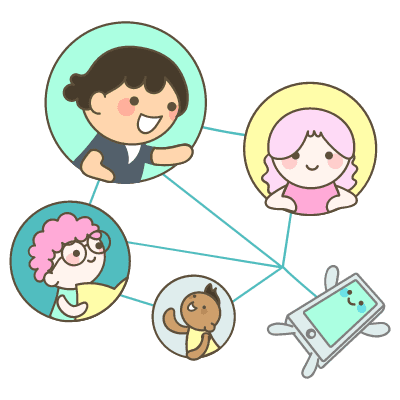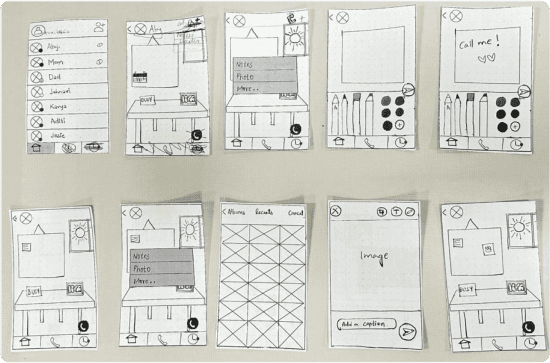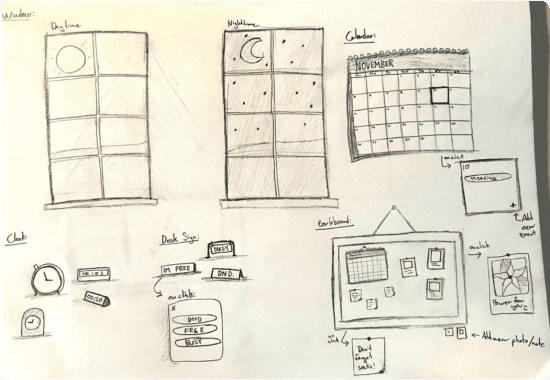Designing for connection.
In a world that’s becoming increasingly independent, co-dependency is what our soul seeks and good design and make that happen.
Tackling a saturated market with a fresh approach
Context
In a world dominated by apps like WhatsApp and FaceTime, we set out to address something these platforms overlook: the emotional side of communication. Time zone challenges and the impersonal nature of virtual interactions leave users feeling disconnected.
This experience taught me the power of thoughtful design in transforming everyday interactions, proving there’s always room for innovation when you focus on human needs.
We reimagined communication as an emotional experience by designing virtual rooms for asynchronous interactions. These spaces, enhanced with time-zone-aware features, helped users build stronger bonds, combat isolation, and improve emotional well-being.



Distance should never be a barrier to meaningful connections, yet for many, it is. Through our research and interviews, we found that people struggling to stay connected with loved ones across different time zones often feel frustrated, disconnected, and even lonely. Scheduling calls becomes a constant puzzle, and the subtle nuances of emotions get lost in texts and even video calls.
These challenges don’t just make communication difficult; they put a strain on relationships and emotional well-being. We believe that staying close to the people who matter most shouldn’t be this hard, and that’s why we set out to find a better way.
Challenges in Long-Distance Communication
The Problem
Our deep dive into long-distance communication uncovered a universal truth:
the true challenge lies not just in staying connected, but in feeling connected.
User Research
Navigating the problem space involved conducting interviews and extensive research to understand the challenges of maintaining emotionally connected relationships over long distances.
User Interviews
Desk Research
What we asked
What communication challenges do you face?
Do time zone differences affect your communication?
Describe any communication misunderstandings you've experienced.
How does distance affect your relationships emotionally?
Findings
A study by Amy Janan Johnson found that 90% of people maintain at least one close long-distance friendship, yet they often struggle to fully understand their friend’s emotions compared to in-person interactions.
Objective
Our objective was to understand the challenges of long-distance communication, how time zone differences, lack of emotional cues, and disrupted routines impact relationships. By analyzing existing studies, we aimed to validate the need for a solution that fosters emotional closeness despite physical distance.
Yasamin Heshmat’s research on "FamilyStories" revealed that time zone differences create significant barriers to real-time communication, making it difficult for family members to stay connected in a natural and spontaneous way.
People naturally prefer real-time conversations over asynchronous ones, as they create a stronger sense of presence (Xiang Cao, 2010). However, mismatched schedules and time zone differences force people into more structured, less spontaneous interactions.
Similarly, Hong Li’s research highlights how this disrupts emotional synchrony in long-distance couples, making it harder to share everyday moments in real time.
Quotes from the Interviewees
"Daylight saving time changes two times a year, and sometimes they will have difficulty understanding what time it is here. Also, sometimes they have some very exciting news to share, and they will call me in the middle of the night."
"For friends, their work typically keeps them occupied from nine to five. Unless I'm willing to rise early in the morning to chat with them, it becomes quite challenging to find a suitable time to connect."
Objective
To understand the emotional and practical challenges faced by both groups in staying connected across time zones.
Participants
10 individuals who rely on digital communication to maintain connections.
Groups Represented
Parents with children living abroad for studies or work and children navigating long-distance relationships with their parents.
Interview findings
Time zones make scheduling calls hard, causing missed connections.
Tech feels impersonal, leading to loneliness and disconnection.
Everyday interactions with loved ones are often missed.
Older family members struggle with new communication tools.
“I feel relieved after talking to them when I'm depressed. Everything becomes okay. But, I can't do that if I know they are sleeping while I'm awake.”
“I usually sense some loneliness when the call ends. It reminds me of how I used to interact with them, and now it's very different for me.”
This storyboard depicts the heartwarming connection between a grandmother and her grandson, separated by distance. A simple app helps them bridge the gap, leading to a joyful virtual reunion.

Story of a virtual reunion
When Distance Fades
Challenges in Long-Distance Communication
The Solution


Our final evaluations with users revealed that RoomConnect was indeed able to create that feeling of being closer to loved ones.
The Outcome
8/10
users said the time zone awareness feature made a significant difference in how they’d plan calls or check in on loved ones.
7/10
users loved the window display feature, saying it helped them visualize their loved one's world in a way that text and video calls don’t capture.
6/10
users felt that the co-customizable corkboard added a personal touch, making RoomConnect feel more intimate than other communication apps.
5/10
users mentioned that this would be useful for international students or older adults who may struggle with time zones or keeping up with spontaneous messages.
7/10
users found the app simple and intuitive, appreciating how easy it was to pick up and use without instructions.
Designed for every generation
Target User Group
Our platform is designed for diverse user groups: adults aged 18–35 living away from home, and parents or grandparents aged 45+ who miss loved ones afar.
We prioritized simplicity to make it accessible for less tech-savvy users, ensuring ease of use for all ages. By connecting families and friends across time zones, the platform bridges distances and strengthens bonds effortlessly.


Insights that shaped our vision
Bridging the Emotional Gap
Our interviews and desk research revealed a need to go beyond traditional communication platforms. This insight guided the vision for virtual spaces that foster personalization, emotional connection, and spontaneity, addressing time zone challenges while mirroring the intimacy of in-person interactions.



90% people have at lease one long distance relationship. Understanding emotions and coordinating across time zones are major hurdles.
Insight 1
People desire real-time interaction but often settle for less due to scheduling conflicts.
Insight 2
Adding personal touches to virtual spaces can significantly improve emotional connection and social interaction.
Insight 3
A closer look at the experience architecture
Core Features



The boys!


Anna
Available

Timezone-Aware Clock
Each room includes a clock displaying the current time in the loved one's timezone, eliminating the need for manual time calculations and helping users recognize and adapt to their loved one's timezone.
Day/Night Indicator
A window in the virtual room indicates whether it's day or night in the loved one's location, further aiding in time zone awareness.
Co-Customizable Corkboard
This feature allows users to leave notes or share photos, enhancing emotional connection.
Emotional Connection Enhancement
The virtual room and corkboard facilitate spontaneous communication without interruptions, reinforcing the bond between users.
Virtual Room for One-on-One Interactions
Users can share a virtual room with their loved ones, fostering a sense of proximity and everyday intimacy in an asynchronous setting.
Long-distance relationships are about finding ways to feel close despite the distance. We identified a need for more than just asynchronous communication, users craved everyday intimacy. To support this, we designed virtual rooms with contextual elements like a timezone-aware clock and a day/night window.
A co-customizable corkboard allows users to leave notes, share photos, and play music, creating a shared space that feels personal and alive. This aligns with Griggio et al.’s findings, which show that co-customization reinforces emotional closeness by turning digital spaces into intimate, co-owned experiences.
Our design rationale is rooted in research
Design Rationale
We brainstormed the visual elements and layout of the room, envisioning how different components would contribute to the overall user experience. We then conducted an internal cognitive walkthrough, simulating user interactions with the prototype to identify potential usability issues and areas for improvement.
Crafting the user journey
From Paper to Pixels



This journey map outlines the key interactions a user experiences on the platform, paired with the emotions each step is likely to evoke, helping us design for not just usability, but a deeper, more resonant user experience.
User Journey Map
RoomConnect pushed me to design not just for functionality, but for emotion. I learned how to balance new ideas with familiar patterns, prioritize accessibility, and iterate with purpose. What made this project stand out was how deeply it connected design with real human needs.
Key Takeaways:
Empathy First: Emotional depth in long-distance relationships informed our core design choices.
Innovation Meets Simplicity: Features like a timezone-aware clock and corkboard were grounded in ease of use.
Inclusive for All: Designing for a wide age range meant making every step feel approachable and clear.
Iterate, Always: User feedback wasn’t just welcomed, it reshaped key decisions.
RoomConnect shaped my approach to empathy, innovation, and inclusive UX
My Learnings


This website is optimized for desktop view, sorry for the inconvenience.
But stay tuned, I'm working on the mobile version.

This website is optimized for desktop view, sorry for the inconvenience.
But stay tuned, I'm working on the mobile version.